←Return to Chapter 5: Writing Full-Time, Sink or Swim
It was fall 1997, and I was still settling into a schedule of writing full-time. It was an awkward transition, going from a life where every single weekday I was on someone else's schedule, to suddenly being in charge of structuring my own workday.
For those of you too young to remember, not very many people were working from home in that era; I can only think of a few at-home vocations: sales reps, real estate agents, and freelancers. And most full-time writers are freelancers. We basically get paid by the job and are constantly working to set up our next gig. But at the time, writing romance novels for traditional publishers was one of the most consistent writing jobs available.
Romance novels were and still are phenomenally popular—they represent about half of all the fiction sold in the United States. The other half is made of every other genre (mystery, thrillers, science fiction, horror, etc.) combined. To supply that demand, traditional publishers were releasing hundreds of romance novels every month that were distributed through bookstores, discount stores, groceries, pharmacies, etc., and direct-to-consumer subscriptions. Publishers like Harlequin, Ballantyne, HarperCollins, St. Martin's Press, Kensington, Dorchester, BET, and Penguin/Random House were buying romance manuscripts. Walmart even got in on the action for a while with their own imprints that were carried exclusively in their stores. Selling a manuscript back then was far from easy, but there was a guaranteed market for writers who were willing to work hard, network, and hold out for their lucky break—because sometimes it did come down to luck, having the right story in the right place at the right time. Most of freelance work is that way—having what the buyer wants when the buyer wants it, and networking to meet those buyers.
I was one of the lucky ones—I was now in the system. I'd sold manuscripts to two publishers—Harlequin and Bantam—and I was working with two editors I liked and who seemed to like my writing.
My third romance novel to be released was License to Thrill for the Bantam Loveswept line in October of 1997, again under the pen name Stephanie Bancroft. My editor asked me to contribute a story to a mini-series called Men of Legend. I could base the hero in my story on any real or fictional hero, and I chose a British agent in the vein of a contemporary James Bond. In License to Thrill, a former agent is tasked with the somewhat superfluous task (in his opinion) of accompanying a priceless historical love letter to America for an exhibit. When the letter is stolen and the curator of the exhibit, a curvy American spitfire, is accused of the theft, the agent has to figure out if she's guilty, and keep her from stealing his heart in the process!
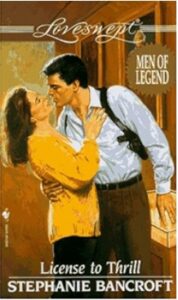
Original cover of LICENSE TO THRILL. By this time, Loveswept had abandoned the short-lived "hero covers" and returned to paintings/illustrations of couples in a "clench" pose.
I had a lot of fun writing License to Thrill. Bantam Loveswept prided itself on offering readers short, contemporary romance stories that didn't fit into a box (a swipe at Harlequin's category romance lines). Indeed, I saw it as a chance to write stories and characters that fell outside the Harlequin guidelines. I made my heroine, Kat McKray, a plus-sized heroine back when body-positivity wasn't a thing! (In my story there's a mention of The Cabbage Soup Diet that was popular in the mid 1990s. Here's a link to a copy of the soup recipe on Food.com.) I leaned on my British literary agent for details on mannerisms and dialogue to portray my hero, James Donovan, as accurately as possible. And License to Thrill was the first mystery I tackled, which would set the tone for future mystery series I would write further into my career. A few years after it was published, I got the rights back to License to Thrill and in 2011, I updated the story and republished it with a new cover:
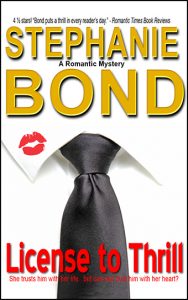
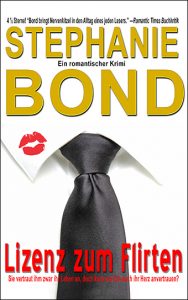
If you missed License to Thrill, it's available everywhere in ebook, print, and audio, and in German!
Back to being a full-time writer… you might be wondering, what WAS I doing all day?
Before an author is published, "the work" is basically a combination of writing and networking to try to sell the writing to a publisher. But once a book is released, "the work" is also promoting the books to booksellers, librarians, and readers. So I had to figure out how to split my workday into two main categories: the writing side of the business, and the business side of the business. My deadlines were my top priority, so I used a big wall calendar to keep track of when manuscripts were due, and production deadlines in between (when revisions and edits were due back, plus art fact sheets, etc.). When I was working on a manuscript, I would literally break down my production by how many words I needed to write every day in order to meet the deadline. Back then everything was handled through the mail, so I had to factor in delivery times.
Logistically, I had a "laptop" that was a refurbished Dell and weighed a ton—like twenty pounds or something, and it was about six inches thick. And it was breathtakingly expensive—around $3500. Plus personal computers back then were pretty glitchy and slow; every work session felt a little precarious. Email wasn't yet common—I had an email address and so did my editors, but when I sent them email, I usually had to call them to tell them to read it! (Are you laughing?) And I went through reams of paper. I bought printer paper like a small business.
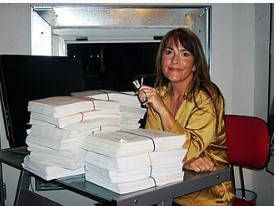
Me at my desk farther into my career with stacks of manuscripts—ugh, look at all that paper!
Any extra time in the day or week I spent on various promotional activities—setting up booksignings and talks, writing articles for exposure, and printing bookmarks and other giveaways for conferences and reader events.
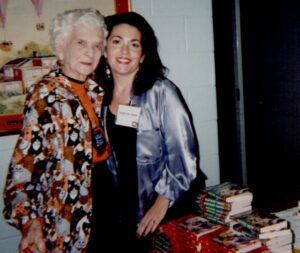
Miss June Ross, who taught me third and fourth grade and whose story would later inspire one of my most popular novels (COMA GIRL), and me, at a booksigning in my hometown of Olive Hill, Kentucky, circa 1998.
I still attended monthly meetings of Georgia Romance Writers (GRW), and the annual Romance Writers of America conference, plus other RWA-affiliated conferences. Writing groups began to invite me to lead workshops and I really enjoyed sharing my newbie knowledge. I absolutely loved everything about the writing industry—I loved the people, I loved the product, and I loved the audience. I felt perfectly situated in my new career, and I was firing on all cylinders. I knew I was still a publishing novice, but I was soaking up all the knowledge I could. I was determined to make a go of being a full-time novelist!
My fourth romance novel was a romantic comedy titled KIDS is a 4-Letter Word published by Harlequin. I love this story! The heroine, Jo Montgomery, is an interior designer and hardcore career woman who doesn’t want kids. But when she finds herself in the middle of someone else's family crisis and a potential client mistakes her for a mommy, she goes along with it… and the lie balloons out of control!
This story was originally released in January 1998 with the following cover, which I really liked:
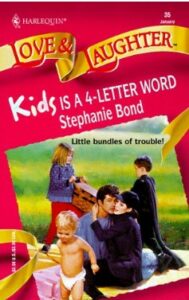
Original cover of KIDS IS A 4-LETTER WORD
Reviews were great, but sales were a little disappointing. My editor later told me booksellers and readers were confused by the title font on the cover—apparently, some thought it was a children's book! It just goes to show how everyone involved in the making of a book cover (including the author!) can get it wrong, ack. The book would go on, though, to be re-released many times (with different covers). The publisher recently reverted the rights and I revamped the manuscript for re-release. And guess what? I still love this story! I had forgotten how positively yummy the hero is. I had to update cultural and technological references, plus I tweaked the writing quite a bit to tighten things up, but I think the story held up pretty well. I put a new cover on it for re-release:
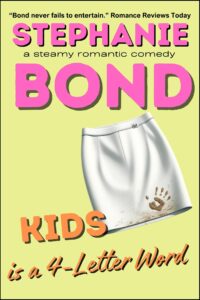
Kids is a 4-Letter Word, newly updated for re-release in ebook and print!)
Reading back over Kids is a 4-Letter Word reminded me how much I love this job. But being a writer is an oddball career—only writers truly understand other writers. I mentioned previously that old friends and new acquaintances couldn't wrap their head around the fact that I was actually working when, in fact, most weeks I worked 60 hours or more. To others, it seemed as if I'd left my stodgy corporate job to do something "fun," so it couldn't be classified as "work." When I attended social get-togethers with non-writers, half the people I talked to were dismissive of my new career, and half the people pelted me with questions about how they, too, could make the leap from the corporate world into a creative job—a question that nearly thirty years later, continues to come up, maybe more now than ever. So in the next chapter, I'll share my advice to aspiring writers, artists, musicians, crafters, and other freelance entrepreneurs for making the leap into a creative career.
Oh, and I'll be sharing more about my books, too! I hope you'll come back! ~